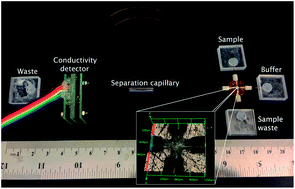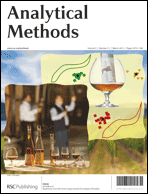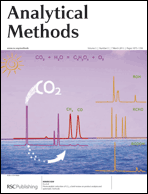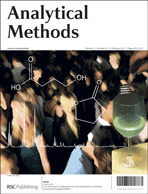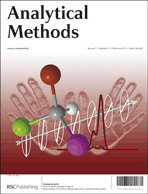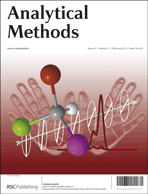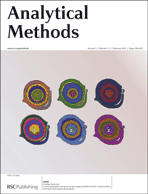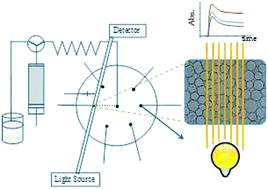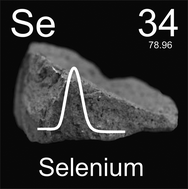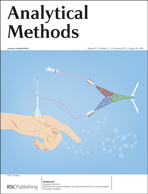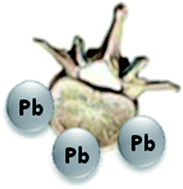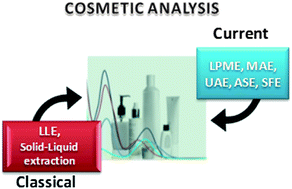Coming along with Analytical Methods Issue 1, here is a great list of HOT papers for you to have a read. These articles cover a large variety of fields, including new methods for discrimination of brain tumours, development of paper-based sensing platforms, novel methodologies for forensic investigations, and improved measurements of volatile organic compounds.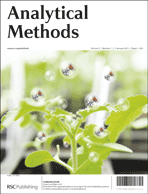
We also have some interesting data on novel detection systems such as detection of thrombin using silver nanoparticles, new ways to detect prion proteins, and the setup of a three-dimensional hydrogel oligonucleotide microarray to detect single nucleotide polymorphisms (SNPs).
Sensitive detection of prion protein through long range resonance energy transfer between graphene oxide and molecular aptamer beacon
Hong Lin Zhuang , Shu Jun Zhen , Jian Wang and Cheng Zhi Huang
Anal. Methods, 2013, 5, 208-212
DOI: 10.1039/C2AY26156A
Direct determination of nickel in xylene solutions of raw material for catalytic cracking with application of graphite furnace atomic absorption spectrometry
Zofia Kowalewska
Anal. Methods, 2013, 5, 192-201
DOI: 10.1039/C2AY25920F
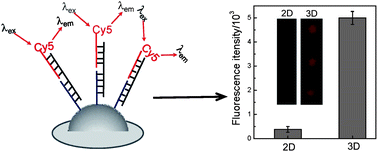
3D-microarray for detection of SNPs
Fabricating three-dimensional hydrogel oligonucleotide microarrays to detect single nucleotide polymorphisms.
Xia Liu , Tao Li , Dianjun Liu and Zhenxin Wang
Anal. Methods, 2013, 5, 285-290
DOI: 10.1039/C2AY25904D
In addition, we present an interesting paper by Jose Garcia who explains how we will be able to detect nanomolar concentrations of Hg by the naked eye.
Sub-ppm quantification of Hg(II) in aqueous media using both the naked eye and digital information from pictures of a colorimetric sensory polymer membrane taken with the digital camera of a conventional mobile phone
Hamid El Kaoutit , Pedro Estévez , Félix C. García , Felipe Serna and José M. García
Anal. Methods, 2013, 5, 54-58
DOI: 10.1039/C2AY26307F
Take a look at all these innovative papers and enjoy the first issue of Analytical Methods in 2013!
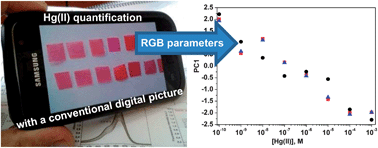
Hg concentration measured using conventional cameras
Progress on the analytical methodology for biological volatile organic compounds
Zhuomin Zhang , Yunjian Ma and Gongke Li
Anal. Methods, 2013, 5, 20-29
DOI: 10.1039/C2AY26082D
A compact comprehensive two-dimensional gas chromatography (GC×GC) approach for the analysis of biogenic VOCs
Samuel J. Edwards , Alastair C. Lewis , Stephen J. Andrews , Richard T. Lidster , Jacqueline F. Hamilton and Christopher N. Rhodes
Anal. Methods, 2013, 5, 141-150
DOI: 10.1039/C2AY25710F
Development of EPA Method 525.3 for the analysis of semivolatiles in drinking water
Paul E. Grimmett and Jean W. Munch
Anal. Methods, 2013, 5, 151-163
DOI: 10.1039/C2AY25880C
Diagnostic segregation of human brain tumours using Fourier-transform infrared and/or Raman spectroscopy coupled with discriminant analysis
Ketan Gajjar , Lara D. Heppenstall , Weiyi Pang , Katherine M. Ashton , Júlio Trevisan , Imran I. Patel , Valon Llabjani , Helen F. Stringfellow , Pierre L. Martin-Hirsch , Timothy Dawson and Francis L. Martin
Anal. Methods, 2013, 5, 89-102
DOI: 10.1039/C2AY25544H
Paper-based electroanalytical sensing platforms
Jonathan P. Metters , Said M. Houssein , Dimitrious K. Kampouris and Craig E. Banks
Anal. Methods, 2013, 5, 103-110
DOI: 10.1039/C2AY26396C
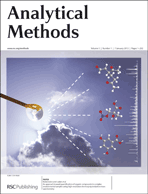 Simultaneous determination of pentachlorophenol, niclosamide and fenpropathrin in fishpond water using an LC-MS/MS method for forensic investigation
Simultaneous determination of pentachlorophenol, niclosamide and fenpropathrin in fishpond water using an LC-MS/MS method for forensic investigation
Haipeng Jiang , Yinhua Zhang , Xiangguo Chen , Jizhong Lv and Jing Zou
Anal. Methods, 2013, 5, 111-115
DOI: 10.1039/C2AY25685A
Photonic and magnetic dual responsive molecularly imprinted polymers: preparation, recognition characteristics and properties as a novel sorbent for caffeine in complicated samples
Shoufang Xu , Jinhua Li , Xingliang Song , Junshen Liu , Hongzhi Lu and Lingxin Chen
Anal. Methods, 2013, 5, 124-133
DOI: 10.1039/C2AY25922B
A sensor probe for the continuous in situ monitoring of ammonia leakage in secondary refrigerant systems
Raman Subramanian , Karl Crowley , Aoife Morrin and Anthony J. Killard
Anal. Methods, 2013, 5, 134-140
DOI: 10.1039/C2AY25688F
Xanthone based Pb2+ selective turn on fluorescent probe for living cell staining
Debasis Karak , Arnab Banerjee , Sisir Lohar , Animesh Sahana , Subhra Kanti Mukhopadhyay , Sushanta. S. Adhikari and Debasis Das
Anal. Methods, 2013, 5, 169-172
DOI: 10.1039/C2AY25935D
Study on the supramolecular interaction of astemizole with cucurbit[7]uril and its analytical application
Guang-Quan Wang , Li-Ming Du , Yu-Hua Guo , Yan-Fang Qin , Jun-Wen Wang and Hao Wu
Anal. Methods, 2013, 5, 173-179
DOI: 10.1039/C2AY25929J
Evaluation of a drop-on-demand micro-dispensing system for development of artificial fingerprints
Jessica L. Staymates , Matthew E. Staymates and Greg Gillen
Anal. Methods, 2013, 5, 180-186
DOI: 10.1039/C2AY26167G
Identification and quantification of methylated PAHs in sediment by two-dimensional gas chromatography/mass spectrometry
Ewa Skoczynska , Pim Leonards and Jacob de Boer
Anal. Methods, 2013, 5, 213-218
DOI: 10.1039/C2AY25746G
Resonant waveguide grating (RWG): overcoming the problem of angular sensitivity by conical, broad-band illumination for fluorescence measurements
Tarmo Nuutinen , Petri Karvinen , Jussi Rahomäki and Pasi Vahimaa
Anal. Methods, 2013, 5, 281-284
DOI: 10.1039/C2AY25470K
